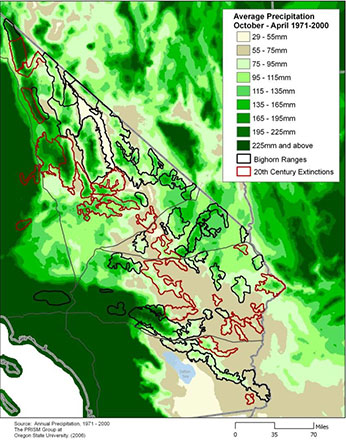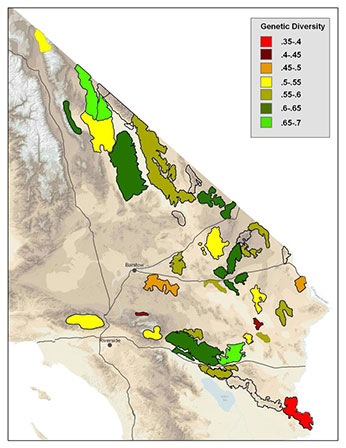Mountain ranges inhabited by desert bighorn tend to be taller in elevation as you travel north. Desert bighorn ranges also have significant variation in cool-season rainfall. Of particular note is the high rainfall along the western extreme and the low rainfall in a south-central part of the desert (see map below).
All desert bighorn sheep in California were once one large metapopulation. Three major interstate highways (15, 40, and 10) have created barriers that split the metapopulation into six fragments. Peninsular bighorn sheep in the Peninsular Ranges are naturally isolated by the wide Coachella Valley, but at one time may have been partially connected to other populations across San Gorgonio Pass. Another metapopulation fragment in the Transverse Range west of Interstate Highway 15 historically may have been isolated by distance, or by tall vegetation in this zone of higher rainfall.
Relative measures of genetic diversity have been analysed for most desert bighorn sheep populations in California. Analyses of resulting gene flow estimates revealed three variables that affect gene flow. First is slope; sheep move much more readily across terrain with a slope of at least 15%, compared with valley bottoms of lesser slope. Second is distance; the larger the distance between mountain ranges the lower the gene flow. Because intermountain movements are essential for the persistence of desert bighorn sheep, mountain and intermountain habitats are equally important habitat components. Third were anthropogenic barriers that have effectively terminated gene flow.
 Cool season (October-April) precipitation variation across desert bighorn sheep habitat in southeastern California with bighorn sheep ranges, including populations that went extinct in the 20th century, many of which now support populations as a result of translocations and natural colonizations. Map by The PRISM Group at Oregon State University (2008).
Cool season (October-April) precipitation variation across desert bighorn sheep habitat in southeastern California with bighorn sheep ranges, including populations that went extinct in the 20th century, many of which now support populations as a result of translocations and natural colonizations. Map by The PRISM Group at Oregon State University (2008).
 Genetic diversity (expected heterozygosity) for desert bighorn sheep populations sampled in California calculated for 11 microsatellite loci. Data are from studies by Wehausen and Ramey (2004), U. S. Fish and Wildlife Service (2007), Epps et al. (2006), Wehausen (2011), and Wehausen (unpubl.). Map by Clint Epps.
Genetic diversity (expected heterozygosity) for desert bighorn sheep populations sampled in California calculated for 11 microsatellite loci. Data are from studies by Wehausen and Ramey (2004), U. S. Fish and Wildlife Service (2007), Epps et al. (2006), Wehausen (2011), and Wehausen (unpubl.). Map by Clint Epps.